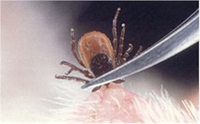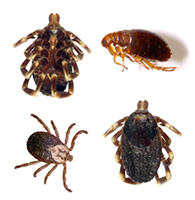Preventing Fleas and Ticks on Pets
Posted by Michelle, founder of Paws pet boutique in Annapolis, MD and PawsPetBoutique.com on 3rd Jul 2015
When the weather turns nice everyone wants to get out and enjoy it including your family pets. 
More and more it seems we hear about the high numbers of pests that can take all the fun out of being outside if the right preparations are not taken. To learn more about fleas and ticks and how they can impact your pets we spoke with Dr. Marianne (Bailey) Holbein, the owner and veterinarian at Queenstown Veterinary Hospital in Queenstown Maryland. Let's find out what we can do so we all can enjoy time with our pets outside.
1. Why is it important to keep ticks and fleas off companion animals?
This is so important for 2 major reasons. First, fleas and ticks carry diseases that can make our pets very sick or kill them. Anemia, Lyme disease, kidney failure, skin infection, and intestinal parasite infections are just a few illnesses caused by pests! Secondly, if your pets have fleas or ticks, they can bring them into the house and you can be exposed to them as well. Preventing flea and tick infections is always easier and less expensive than treating them after there is a problem.
2. What do you recommend doing if you find a flea or a tick on your pet?
If you find a flea or tick, remove it immediately. Use a pair of tweezers to secure the head of a tick and remove it. If you have any trouble removing it, call your veterinarian.  After you have checked
your pet over, you want to evaluate your prevention plan. Are you using a
monthly flea and tick preventative? Are you applying it correctly? When used
properly, these products are extremely effective at preventing infections. If you
have any questions about bites from a flea or tick, call your veterinarian to
have them examine your pet. Some flea infections can cause secondary skin
infections that need to be treated with antibiotics.
After you have checked
your pet over, you want to evaluate your prevention plan. Are you using a
monthly flea and tick preventative? Are you applying it correctly? When used
properly, these products are extremely effective at preventing infections. If you
have any questions about bites from a flea or tick, call your veterinarian to
have them examine your pet. Some flea infections can cause secondary skin
infections that need to be treated with antibiotics.
3. Are there symptoms my pet will exhibit if they have been impacted by a flea or tick?
Pets with fleas will often bite or scratch. In dogs we normally see this in the "pants" area which is around the tail, the hind legs and the lower back of the pet. Cats will often times have small crusts or scabs around the flank or the face and neck area. If you use a fine tooth comb in the fur, you will black specks that look like pepper in the fur. This is actually dried blood from the tick bite. Pets with a flea allergy will be very itchy and uncomfortable while some might not be as severely bothered. Dogs with ticks may not show any signs initially. It can take 24-48 hours after attachment for ticks to transmit a disease to dogs and they might not test positive for tick-borne disease for 4-6 weeks. The most common signs of tick bites in dogs are raised, red areas that are not itchy. These can take a few weeks to go down. Dogs with tick borne illnesses will typically seem lethargic, may be sore or limping and may have changes in appetite. You may never know your dog was bitten by a tick before it shows signs of illness. Cats rarely develop or show signs of tick-borne disease but we still recommend monthly prevention.
4. If my pet
test’s positive for Lyme, Rocky Mountain Spotted Fever or Ehrlichiosis is there  anything that can be done to treat and remove the disease? Will they be able to
live a normal life?
anything that can be done to treat and remove the disease? Will they be able to
live a normal life?
A positive test result could mean exposure to a tick carrying a disease or may indicate a true infection, depending on the type of test that has been run. Many of our yearly screening tests are not sensitive enough distinguish between the two. If your pet tests positive, your veterinarian will start them on an appropriate antibiotic and run any additional tests needed. Lyme Disease can cause kidney failure in the retriever breeds so blood work and an urinalysis would be recommended. Depending on what signs your pets are showing, different medications will be started.
5. Are there any natural preventive measures I can take to protect my pet?
There are a lot of natural remedies and herbal supplements that are recommended on pet blogs online but there are none that have studies I have seen to support them. Something natural you can do is to keep your environment pest flea! Eliminate puddles or areas of standing water, keep the grass cut short and dead wood/ stick piles cleaned up. These are often areas where you will find a high number of ticks. Even furniture that is never used or at the wood line can be an area where ticks may breed and be found in high numbers.
6. As a Vet, what do you recommend for keeping these bugs away from dogs and cats?
There are many products available for you to use including Frontline Plus, Advantix and Nexgard. These products have been tested for safety and will be the best products to use on a monthly basis. Your veterinarian should be able to offer a topical product to prevent against fleas and ticks or my favorite which is a new chewable flea and tick product called Nexgard. Another safe and effective option is the Seresto collar but remember to mark your calendar when it needs to be replaced! Also, make sure every pet in the home is on the preventative. It is important to check your pets for ticks after going on walks and hikes and keep your yard maintained. High grasses and areas with dead treats or sticks piled up can be perfect spots for ticks to breed.
Thanks to Dr. Holbein for sharing her insights and knowledge on pets and pests! For more information, or to contact her, visit www.QueenstownVet.com or call 410-827-6776. Watch our Paws Blog for more helpful pet tips coming soon!

